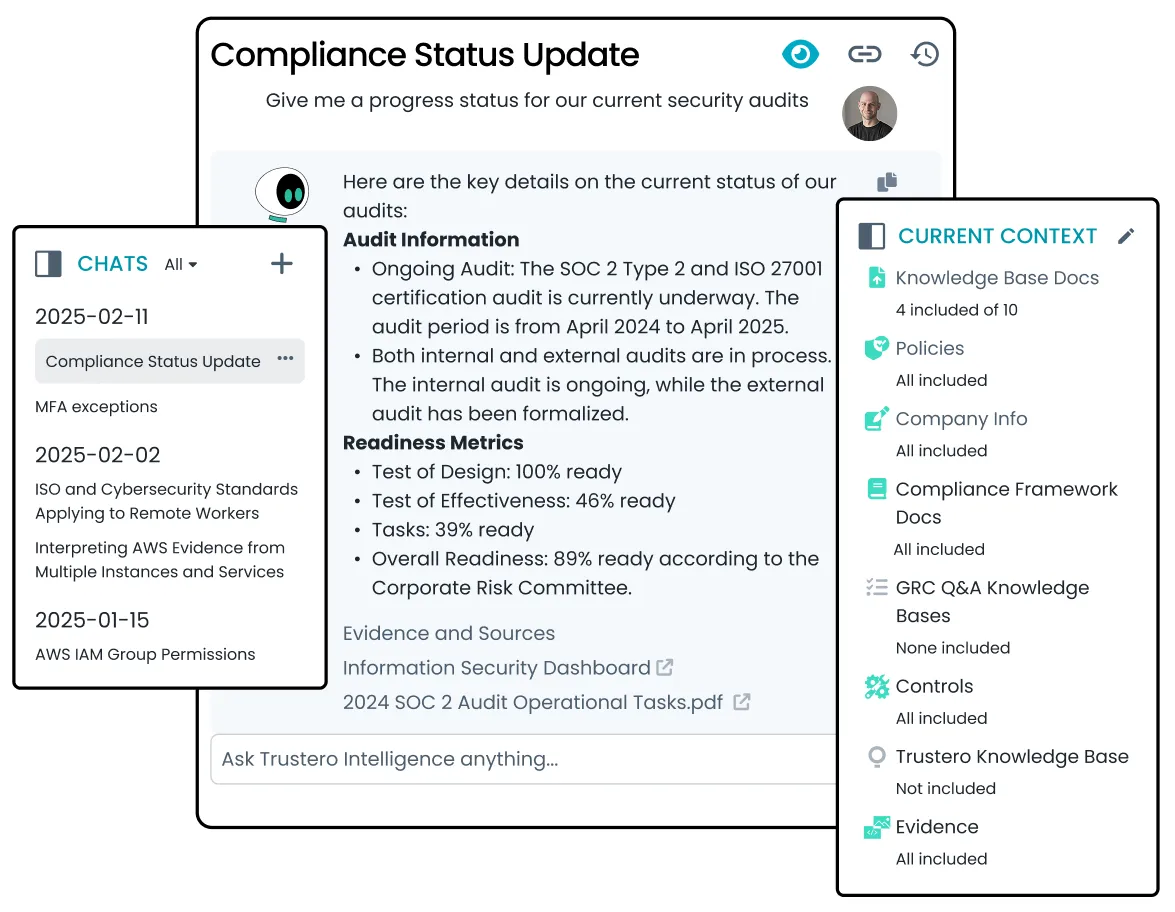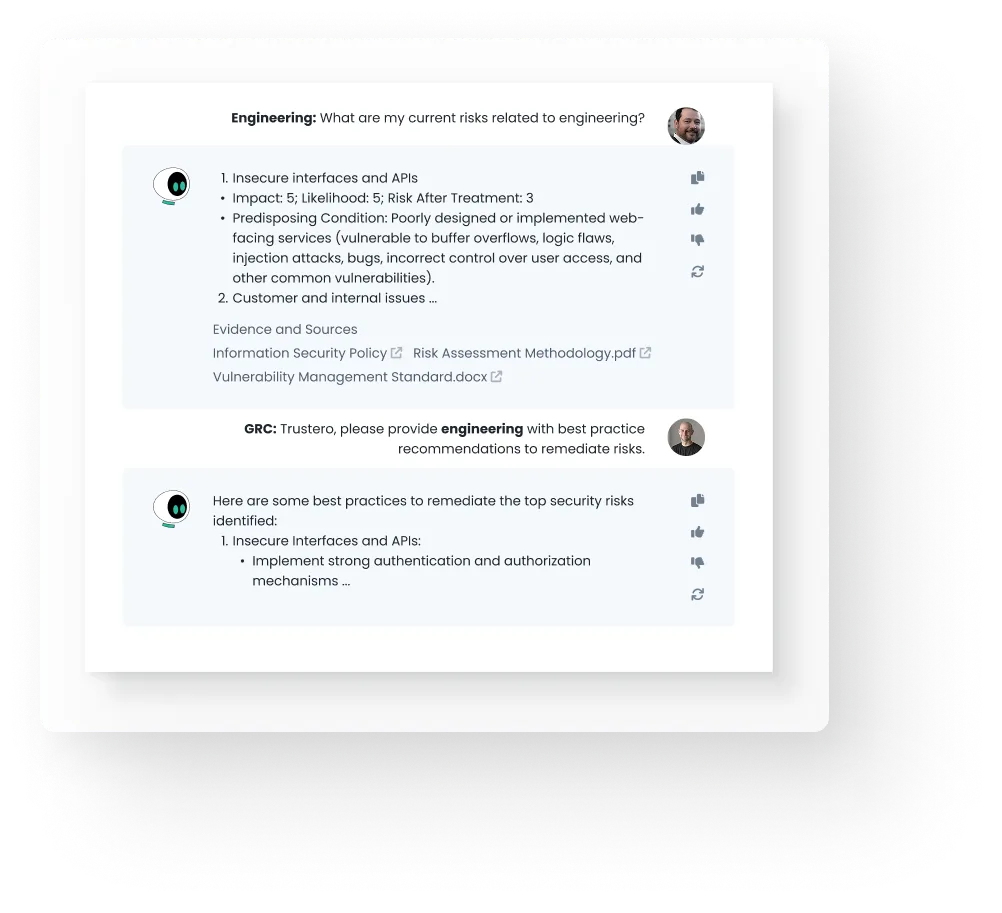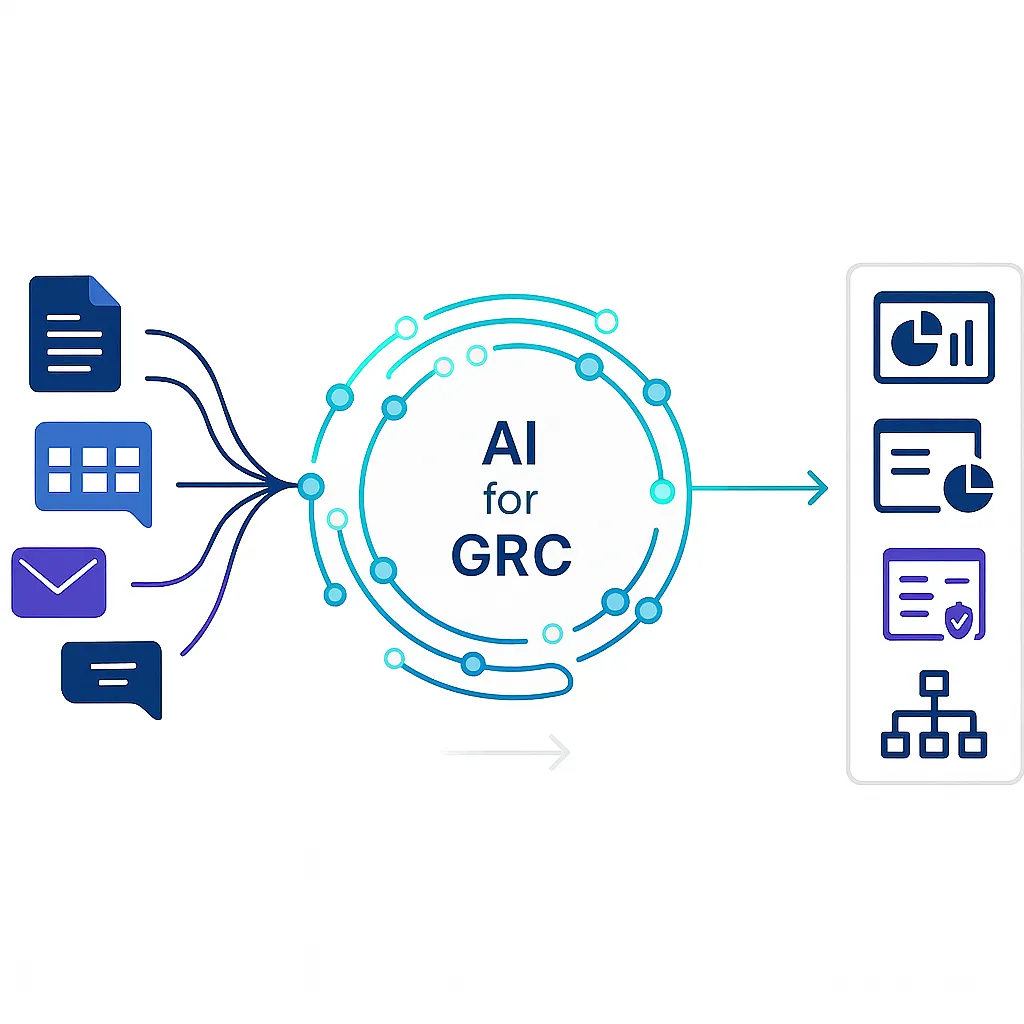In GRC, the data is always somewhere — but rarely all in one place.
Policies live in shared drives. Vendor attestations hide in portals. Control documentation sits across platforms - or in someone’s inbox.
And when it’s time to answer real questions like, “Are we covering applicable threats?” or “Do our policies align with our frameworks?”, you’re stitching together 10 things to answer 1.
Trustero Intelligence (TI) Playbooks solve this by bringing the data - and the logic - together.
Sometimes that means integrating with your existing platform data. Other times, it’s as simple as uploading the right document or copy-pasting the content directly into TI Chat.
No matter where the data starts, TI Playbooks guide you through collecting, analyzing, and validating the full picture - without needing a new module or custom feature.
That’s why we built them: to close the gaps traditional platforms can’t predict, with workflows your team can actually use.
The Problem: GRC Isn’t Linear, and Platforms Can’t Predict Everything
Trustero has purpose-built features for control mapping, evidence collection, audit readiness, and more. But GRC doesn’t happen in neat boxes. Every customer, every program, every audit has edge cases.
- New frameworks not fully mapped yet
- Custom controls
- Uncommon evidence formats
- Risk scenarios without an official “module”
Until now, those gaps meant doing it manually or doing without.
The Solution: Trustero Intelligence Playbooks

TI Playbooks let you structure and repeat ad-hoc workflows inside Trustero Intelligence - even if we haven’t built a first-class feature for it yet.
These aren’t rigid templates. They’re AI-powered workflows, generated from real questions, that:
- Gather scoped context from across your platform (and documents)
- Coordinate multiple AI “agents” behind the scenes
- Show their reasoning and intermediate steps
- Deliver structured, repeatable results
Once created, a playbook can be saved, reused, or even shared - so teams don’t have to start from scratch every time.
Why This Matters
Most GRC platforms ask you to change your process to fit their tooling. Playbooks do the opposite.
They help you tackle the exact problem you’re facing - right now - with the context, logic, and depth required.
- No waiting for a feature to be built
- No stitching together insights from 10 systems
- No guessing what a prompt should say
Just clarity. Fast.
What Can You Solve with TI Playbooks?
These workflows are already unlocking use cases that would typically require a consultant or spreadsheet acrobatics:
Framework Alignment
- Are our policies covering all required framework objectives?
- Where do control designs need more coverage or clarity?
Evidence & Test Validation
- Are test procedures clearly validating the stated control objective?
- Can AI recommend stronger tests based on existing evidence?
Threat & Risk Coverage
- Do we have risks documented for all applicable threat vectors?
- Where are we underrepresented in our risk register?
Vendor Management
- Beyond SOC 2, what does this PCI attestation tell us?
- What are the risk implications of this vendor’s reported gaps?
Each of these use cases can be structured into a repeatable playbook - using the data already in your platform plus trusted external references.

How It Works
Each TI Playbook is a structured workflow made up of expert-designed prompts, connected data, and AI agents working in sequence. You can run a playbook today by using the guidance available in the Support Portal - copy and paste the prompts, and TI will take it from there.
Behind the scenes, multiple agents will:
- Pull relevant platform data
- Ask clarifying questions as needed
- Coordinate the analysis across steps
- Show their work - yes, including intermediate reasoning
- Deliver structured, validated artifacts you can act on (and reuse)
And you’ll get structured, validated artifacts you can act on - and reuse.
Coming Soon: A Growing Library of Playbooks
As more customers create and share playbooks, we’ll build a gallery of workflows for the most common and high-impact GRC use cases.
This creates something powerful: A network of practitioner-defined intelligence - accessible to all, immediately actionable.
Closing Thought
TI Playbooks aren’t just a feature. They’re a new way to work - fast, contextual, and grounded in what GRC teams actually need to do.
You shouldn’t need 10 tools to answer 1 question. With Trustero Intelligence, now you don’t.
Next Week: Threat Assessment Playbook
Our first official playbook helps teams quickly assess whether their current risk register covers all applicable threat vectors. It’s a fast, guided process using Trustero Intelligence to:
- Gather scoped business and regulatory context
- Analyze external threat reports
- Identify threat gaps
- Suggest structured risk entries for anything missing
📘 Read the other installments in this series to see how we got to our playbooks:
- AI in GRC: From Theory to Reality - How People Are Actually Using It
- It's Working...Until It's Not: Why GRC Needs More than AI Promises
And stay tuned for my next installment in this series, where I introduce you to the Threat Assessment Playbook and how teams are using it today.
Note: Full prompt guidance and detailed setup instructions are available to existing Trustero customers via the Support Portal.

